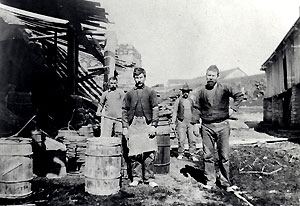The State Historical Resources Commission on May 3 granted approval for listing UCSC's Cowell Lime Works Historic District on the National Register of Historic Places.
The historic district, which was nominated by UCSC, is an area of about 30 acres around the main entrance of the campus on either side of Coolidge Drive. The district includes historic buildings and lime production features and related support facilities that date to the latter half of the 19th and early 20th centuries.
The UCSC campus was established on lands that once were part of the Cowell Ranch. Henry Cowell, a major industrialist in central California, operated a large complex of industrial lime production and support facilities scattered throughout what are now campus lands. His local holdings also extended widely into surrounding areas. Lime, which was produced at the campus site by burning limestone in large redwood-fired kilns, was critical in the manufacture of cement and also was used in a number of other industries.
The complex of historic buildings and features that have been included in the campus's historic district are of particular historic value because they represent the full range of facilities needed in a historic rural industrial operation, including both lime-processing facilities and also ranch and worker-support buildings.
Prominent on Coolidge Drive are the Cooperage and the lime kilns and several small quarries, which can be seen along Coolidge Drive. Limestone from these and other larger quarries was burned in the kilns, and the product was packaged in barrels manufactured at the Cooperage (the long structure on stone pillars). The remnants of the tramway trestle and rail bed used to carry limestone and redwood from the upper campus can also be seen along Coolidge Drive. Also included in the district are several of the barns and the Blacksmith's Shop used in the care of the draft animals used on the limeworks and ranch.
A historic horse barn, now the Barn Theater, is at the northwest corner of High Street and Coolidge Drive. In addition, the district includes the Cookhouse (now the campus Admissions Office), where ranch workers were fed, as well as ruins and archaeological remains of several workers' cabins. Finally, the district includes the ranch owner's house, know as Cardiff House, now the Women's Center, and the entry gate and drive to the house, which can been seen on High Street just east of the campus entrance.
Henry Cowell dominated the masonry supply business in northern California during the late 1800s. When he died in 1903 he owned property in 23 California counties. Besides lime-manufacturing plants, dairies, and cattle ranches, he was involved in banking, real estate, shipping, warehousing, and had financial interests in a railroad and hotel. Due to the family's philanthropy, the Cowell name is on a college at UCSC, several university health centers, and several parks. The S. H. Cowell Foundation continues to be one of northern California's major foundations, supporting social causes. Henry Cowell and his legacy have had and continue to have an important impact in northern California.
The campus has drafted a management plan for the district, which is under internal review. This includes measures to enhance the historic appearance of the district, as well as recommendations for future treatment of surviving buildings. Preservation recommendations have been taken into account in the recent seismic retrofit of the Cookhouse, and recent repairs at the Granary (now a campus childcare center). Barn H, in the campus corporation yard, was recently stained white, for consistency with the historic appearance of these farm buildings. The campus has also conducted historic archaeological excavations in conjunction with work within the district, and is preparing public interpretive signage to inform the public about the history of the site.
A campus grant application for seismic retrofit of the historic Paymaster's House (a small stone building near the campus entrance) and interior remodeling for use as a curatorial and archaeological research facility is under consideration by the California State Historical Endowment.
Related links:
Lime Kiln Legacies, an anthology of articles published by the Santa Cruz Museum of Art and History.
Local history: Economic Development of the City of Santa Cruz 1850-1950



